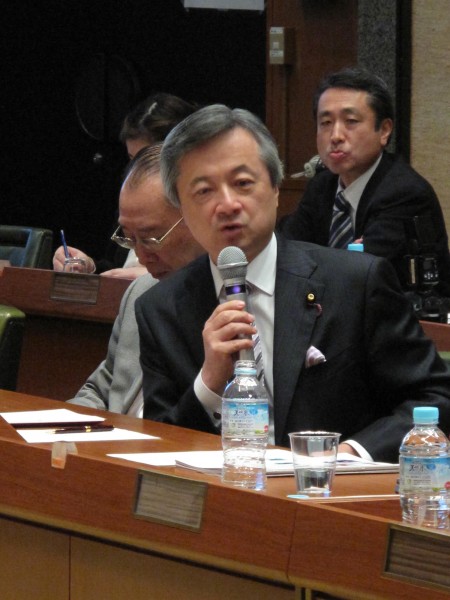On 13 December, religious leaders, disarmament experts and civil society advocates met at the Fumon Hall in Tokyo, the centre of the Buddhist order Rissho Kosei-kai, to participate in the launch of the Japanese version of a Nuclear Disarmament Guide for Religious Leaders and Communities which has been produced by Religions for Peace.
我々が立脚する崇高で共通の基盤からして私は、グローバルな核軍縮を含め、我々に共通する人間性をより強く認識しようと継続的に活動を展開するレリジョンズ・フォー・ピース(Religions for Peace)に対して賞賛の意を表します。Religions for Peaceの新たな出版物である「宗教指導者と共同体のための核軍縮に関する実践情報ガイド」は、核兵器のない世界に向けての喜ばしい前進であります。― 国連事務総長 潘基文のメッセージ Because of their large membership and principled positions, religious groups in particular have enormous potential to advance nuclear disarmament worldwide.
Its new publication “Resource Guide on Nuclear Disarmament for Religious Leaders and Communities” is a welcome step forward on the road to a nuclear weapon–free world.
Message by Ban Ki-moon, Secretary-General of the United Nations, for the UN launch of the Religions for Peace Nuclear Disarmament Resource

Rev Sugitani launching the Nuclear Disarmament Resource Guide
The event was opened by the Venerable Gijun Sugitani, Chair of Religions for Peace Japan and also Chair of the Religions for Peace International Standing Commission on Disarmament and Security. Rev Sugitani spoke of the important role that religious leaders and communities have to play in advancing peace and nuclear abolition. 'Nuclear weapons are threats to all life forms; it is not an exaggeration to say that nuclear weapons threaten national security, rather than protect it.' Rev Sugitani asserted that in order to address the problems confronting humanity today, including the threat from nuclear weapons, 'we need to consider human centered security that transcends national borders. This is none other than the concept of shared security which involves collective actions to protect all life forms and is what religious leaders should aspire to.'

Rev Sugino introducing the Nuclear Disarmament Resource Guide
Rev. Kyoichi Sugino, Deputy Secretary General of Religions for Peace International, noted the long-standing engagement of Religions for Peace in nuclear disarmament, and explained the need for the Nuclear Disarmament Resource Guide to assist religious communities in discussing and supporting nuclear disarmament initiatives. Rev Sugino noted that the English versions of the Nuclear Disarmament Resource Guide had recently been launched to the international diplomatic community at the United Nations and to the global inter-faith community at the Religions for Peace Assembly in Vienna. The Japanese edition is the first translated edition to be produced. Editions in other languages such as Arabic, French and Spanish are planned.

Alyn Ware outlining the contents of the Nuclear Disarmament Resource Guide
Alyn Ware, principal author of the Nuclear Disarmament Resource Guide, began by honourring the Hibakusha - the survivors of nuclear bombings of Hiroshima and Nagasaki - who had been tirelessly advancing the call for nuclear abolition for 68 years. Mr Ware emphasised the importance of religious communities becoming even more active in this issue - especially on an inter-faith basis - as religious communities have the capacity to reach beyond national borders in order to advance the cooperatve security approaches required to abolish nuclear weapons. Mr Ware also highlighted the importance of religious youth and women to be involved, and noted the special sections on youth and women in the Resource Guide. Mr Ware also noted the importance of religious communities engaging with other constituencies to ensure success, including governments, parliamentarians, academics and civil society. Mr Ware welcomed the representatives from these constituencies that were participating in the launch event.
Rev. Masamichi Kamiya, Principal Translator of the Resource Guide, highlighted the new opportunities for nuclear disarmament and noted some of the inspirational statements and examples of action in the Nuclear Disarmament Resource Guide. He reported on having learned a lot by translating the resource, and encouraged everyone else to read it and also be inspired.

Shinkun Haku - Member of the Japan Parliament House of Councillors - speaking at the launch
Several religious leaders (Buddhist, Christian and Muslim) made contributions to the ensuing discussion - as did Nobuyashu Abe (former United Nations Under-Secretary-General), Shinkun Haku (Member of the Japan Parliament House of Councillors), Hiromichi Umebayashi (Professor from the Nagasaki University Research Centre for the Elimination of Nuclear Weapons) and Akira Kawasaki (Peace Boat).
Alyn Ware concluded by reflecting on the meaning of the coloured origami cranes on the cover of the Resource Guide. The origami crane, a traditional Japanese sympbol of peace and a healthy life, has become a global message for nuclear abolition arising from the story of Sadako and the Thousand Cranes. Young people all over the world now know the story and make origami cranes as their action for peace. The different coloured cranes on the cover of the Resource Guide represent the different religions cooperating for the shared goal of a nuclear-weapon-free world.
For more information on obtaining or using the Nuclear Disarmament Resource Guide, please contact info@baselpeaceoffice.org or dsingh@religionsforpeace.org
